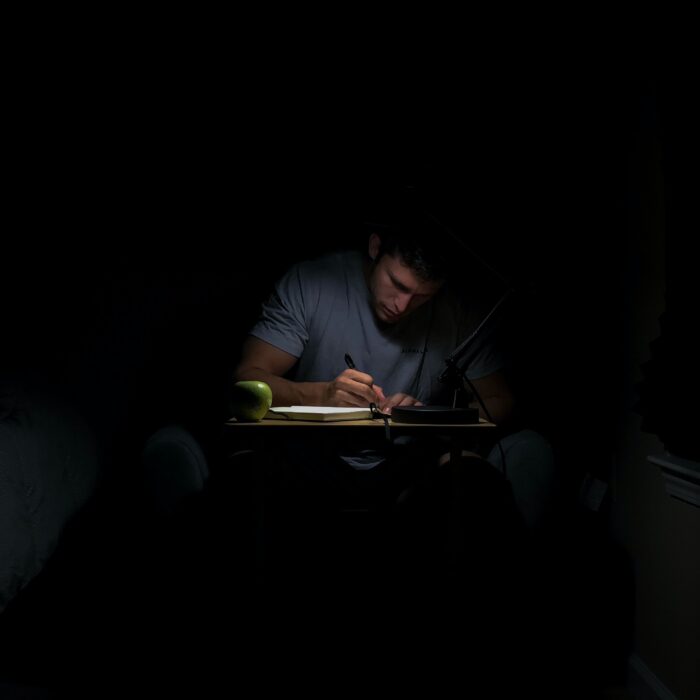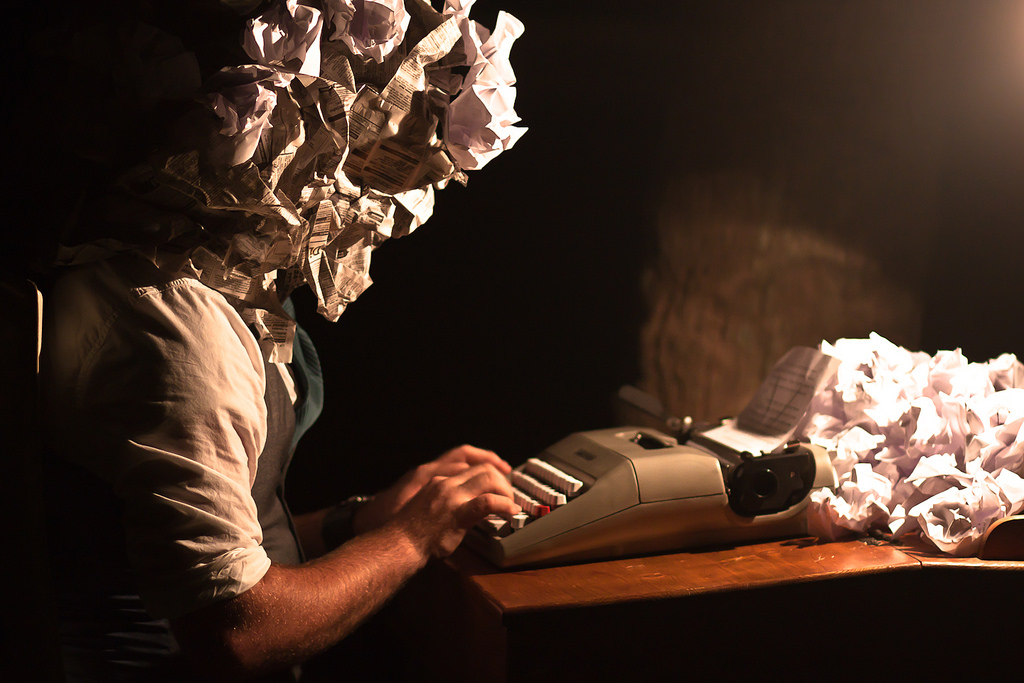You have no items in your cart. Want to get some nice things?
Go shopping“Begin at the beginning, and go on till you come to the end: then stop.”
So says the King of Hearts to the White Rabbit in Alice’s Adventures in Wonderland, instructing him and a host of wide-eyed young readers on the magical art of storytelling. We learn that it couldn’t be simpler, really: every story has a beginning, a middle and an end. In fact, there’s very little magic involved at all. We just have to start at the right place, then tell the story until there is nothing left to say. What could be easier?
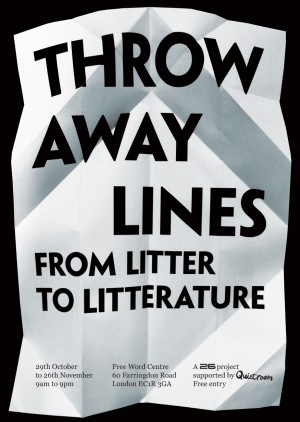 If the King of Hearts had paid a visit to the Free Word Centre last month, he might have had to rethink his stance. On show was an exhibition, Throwaway Lines, that had a pretty good go at tearing up the storytelling rulebook: fifteen pieces of art based on short stories that were in turn inspired by scraps of discarded writing found on the street, be they shopping lists, angry diatribes, letters or distracted musings. Multiple beginnings, middles and ends rearranged and reimagined across different mediums to create a new kind of storytelling experience—one that we might not even recognise and which demands that the reader fills in the gaps.
If the King of Hearts had paid a visit to the Free Word Centre last month, he might have had to rethink his stance. On show was an exhibition, Throwaway Lines, that had a pretty good go at tearing up the storytelling rulebook: fifteen pieces of art based on short stories that were in turn inspired by scraps of discarded writing found on the street, be they shopping lists, angry diatribes, letters or distracted musings. Multiple beginnings, middles and ends rearranged and reimagined across different mediums to create a new kind of storytelling experience—one that we might not even recognise and which demands that the reader fills in the gaps.
Call this pretentious hipster waffle or declare it inventive, avant-garde literature; either way it provokes a debate on what it means to write, how we tell stories, and what the intentions behind reading and writing a story are. For it is not just the White Rabbit who wanted to know how a story should be told; a fixed storytelling structure has informed the way we create and perceive writing for years.
Take the novel, for example: such is its preeminence (which belies its relative “novelty” in the history of literature) that its traditional structure and style have come to dominate the way we think about reading and writing. There’s always a story, of course: it starts somehow, any number of things may happen before, finally, it comes to a close. Countless variations can be achieved using this medium, and curious and original devices are often used to great effect; but it’s hard to escape the fact that by opening a book, we are accepting a beginning; and by reading its final words, we are acknowledging an end.
Is it ever possible, then, to write and read outside these traditional narrative structures? And do authors even bear them in mind when they write? Short story writer Jackie Kay has commented that she often starts a short story with a character or image, which she can then flesh out and develop, and therefore writes in a very different way to how we end up reading. If authors don’t necessarily write the beginning first and the end last, should we be reading in that order? Going one step further are books like Hopscotch (1966) by Julio Cortázar, which includes “expendable” chapters and multiple endings, and House of Leaves (2000) by Mark Z. Danielewski, which disorientates the reader with footnotes within footnotes and typographical mayhem, refusing us the reassuring beginning, middle and end we know so well. This kind of innovative reader-interaction is taken to its logical conclusion in this year’s wonderfully original Building Stories by cartoonist Chris Ware—a box full of books and pamphlets that can, theoretically, be read in any order, and which, by its own design, cedes control of the narrative to the reader.
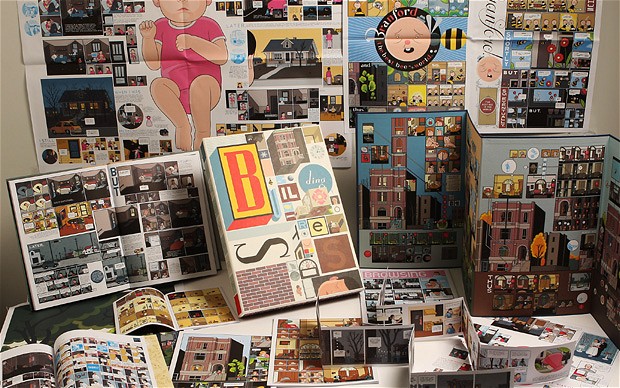
Building Stories is Kindle-proof. I can’t even begin to imagine how this would work digitally—and the kind of object technophobes might hold up as evidence that ebooks can never compete with the printed book. But, like our King of Hearts, modern-day Luddites shouldn’t speak too soon. The widespread digitisation of media—particularly the Internet and all that comes with it—has revolutionized the way we read, write and interact, for good and bad.
Right now, for example, I might be writing this but in the background there are six browser tabs open, I’m halfway through three different articles and I’m dipping in and out of Twitter, vaguely looking for something that might catch my eye. Distraction, then, is a bit of a problem—writer Kevin Barry recently admitted to checking his emails about 150 times a day—but the Internet is also an incredible source of literature, and one that is constantly expanding and developing.
Forums, blogs and fan fiction websites present us with an unimaginably wide selection of genres, forms and styles from which to choose. Interestingly, there is something of a revival of old “methods” in the way in which chapters are released one by one, echoing nineteenth-century serialisations. Twitter, often hailed for its immediacy and brevity, has also been used as a platform for serialised reading and writing: Jennifer Egan’s short story “Black Box” was released line by line on the social media site, and the #TwitterFiction Festival is currently underway. Enhanced ebooks and apps, too, invite us to interact with our books in a different way. Embedded videos and audio add an extra dimension to our reading experience, while interactive apps can entirely reimagine and reorder a book or series we thought was set in stone.
Writing practices are changing and, with them, reading practices. But does it make that much difference? Ebooks and digital content might change the way we like to receive our words, but as long as we still want to read, surely it doesn’t really matter? The current proliferation of new storytelling mediums is likely to hold firm for some time, but it’s also likely that we’ll gradually filter out the less successful examples to end up with a perfectly manageable, new kind of storytelling. All we can really do is wait and see.
What, then, of the beginning, middle and end? They are concepts that seem fixed within our storytelling experience, but they have in fact always been satisfyingly malleable—played with and adapted countless times over the years. After all, is an ending ever really fixed? What about the millions of other possible endings the writer sets off in the reader’s mind? Does a story have to end?
You decide.
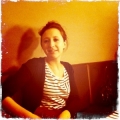
About Bella Bosworth
Bella Whittington reads and reviews a bit of everything, but is particularly interested in literary fiction, translations and short stories. After living in Spain for a year, she now works as an assistant editor for Transworld Publishers in London. She has also contributed to Thresholds, the University of Chichester's international short story forum, and the Harker.

